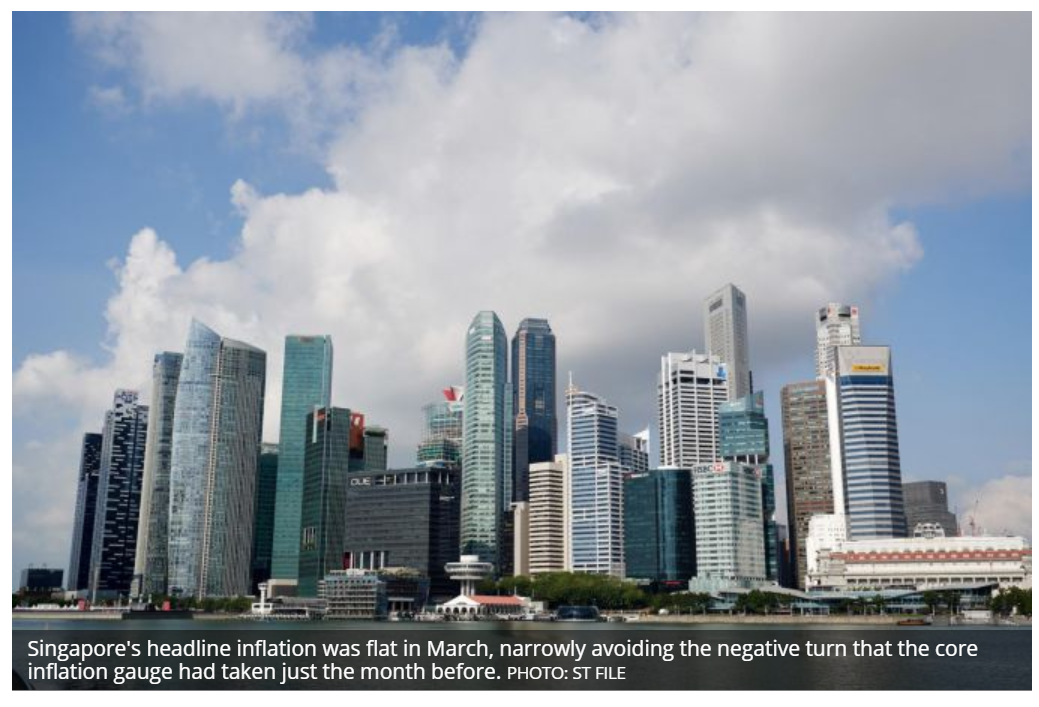Singapore headline inflation falls to zero in March
SINGAPORE’S headline inflation was flat in March, narrowly avoiding the negative turn that the core inflation gauge had taken just the month before.
The all-items consumer price index (CPI) was unchanged year on year, easing from the 0.3 per cent uptick in February, according to official data released on Thursday. This beat the median contraction of 0.2 per cent predicted by private-sector economists in a Bloomberg poll.
Meanwhile, core inflation, which the Monetary Authority of Singapore (MAS) uses as a guide for monetary policy, fell deeper into the negative zone in March.
In line with economists’ predictions, core inflation weakened to -0.2 per cent from -0.1 per cent in February. The central bank metric strips out accommodation and private road transport costs.
Now, with the Covid-19 pandemic locking down the world the MAS and the Ministry of Trade and Industry (MTI) noted in their outlook statement that Singapore’s safe-distancing measures and weaker domestic labour market conditions “will dampen consumer demand, thereby capping price increases for discretionary goods and services”.
“Domestic cost pressures are likely to remain low as some degree of spare capacity in the economy emerges. Inflation is thus expected to remain subdued,” they added.
Overall inflation slipped in March on the back of steeper declines in the cost of services such as education and healthcare, the data showed.
Services inflation fell to -0.7 per cent from -0.4 per cent in February, with the MAS and MTI citing lower costs for point‐to‐point transport services and telecommunication services, as well as larger declines in healthcare and holiday expenses.
“Prices of outbound travel‐related items will decline, given the sharp reduction in aviation and tourism activities globally,” they warned in their joint statement.
Still, food costs went up by 1.5 per cent, just a hair’s breadth below the 1.6 per cent increase in February. Meat, vegetable and bread and cereals drove the price hike, and the authorities noted that “international measures to contain the Covid-19 outbreak have led to supply chain disruptions, which could put some upward pressure on imported food price”.
The decline in electricity and gas costs cooled to 6.2 per cent from a 7.4 per cent contraction in February, as the take‐up of Open Electricity Market plans slowed.
Price decreases in retail and other goods also eased to 0.9 per cent, down from 1 per cent before, on smaller declines in the costs of recreational goods and medical products.
Private transport costs fell by 0.3 per cent year on year in March – against 2.4 per cent growth in February – as petrol prices and parking fees went down, even though accommodation costs rose by 0.5 per cent, up from 0.4 per cent before, on stronger housing rentals.
OCBC Bank chief economist Selena Ling suggested that rents may have felt an uplift from the movement controls that were first imposed across the Causeway in March, as Malaysian workers in Singapore were left “scrambling for temporary accommodation”.
With the possibility of an extension to Malaysia’s lockdown, “the housing rental inflation segment may sustain into April at least”, she remarked.
Ms Ling added that Singapore’s own circuit breaker “is also likely to dampen business confidence, weigh on hiring intentions and further curb consumer appetite for discretionary spending”.
The MAS and MTI have affirmed the full-year forecast range of between ‐1 per cent and zero, for both all-items and core inflation. The official estimates had already been downgraded in end-March from a positive outlook of between 0.5 per cent and 1.5 per cent.
“Weak global price pressures and limited domestic price pressures, including softer commercial, retail rents and limited wage pressures, have contributed to Singapore’s softer core inflation in recent months, and we expect the same dynamics to persist in the coming quarters,” said JPMorgan’s Ong Sin Beng, who expects stabilisation and a slow recovery in the second half.
Barclays economist Brian Tan warned in a note of a rising risk that the MAS will ease monetary policy for the second time this year at its October meeting. “An extended period of economic disruption will likely erode the economy’s ability to recover after the government’s so-called ‘circuit breaker’ ends, favouring further (currency) policy easing,” he said.
Mr Tan believes that any easing would be through another downward re-centring of the policy band in which the Singapore dollar can move. The Singdollar’s pace of appreciation was already cut to a zero per cent “flat slope” at the half-yearly review in April.
Source: https://www.businesstimes.com.sg/government-economy/singapore-headline-inflation-falls-to-zero-in-march


 English
English




